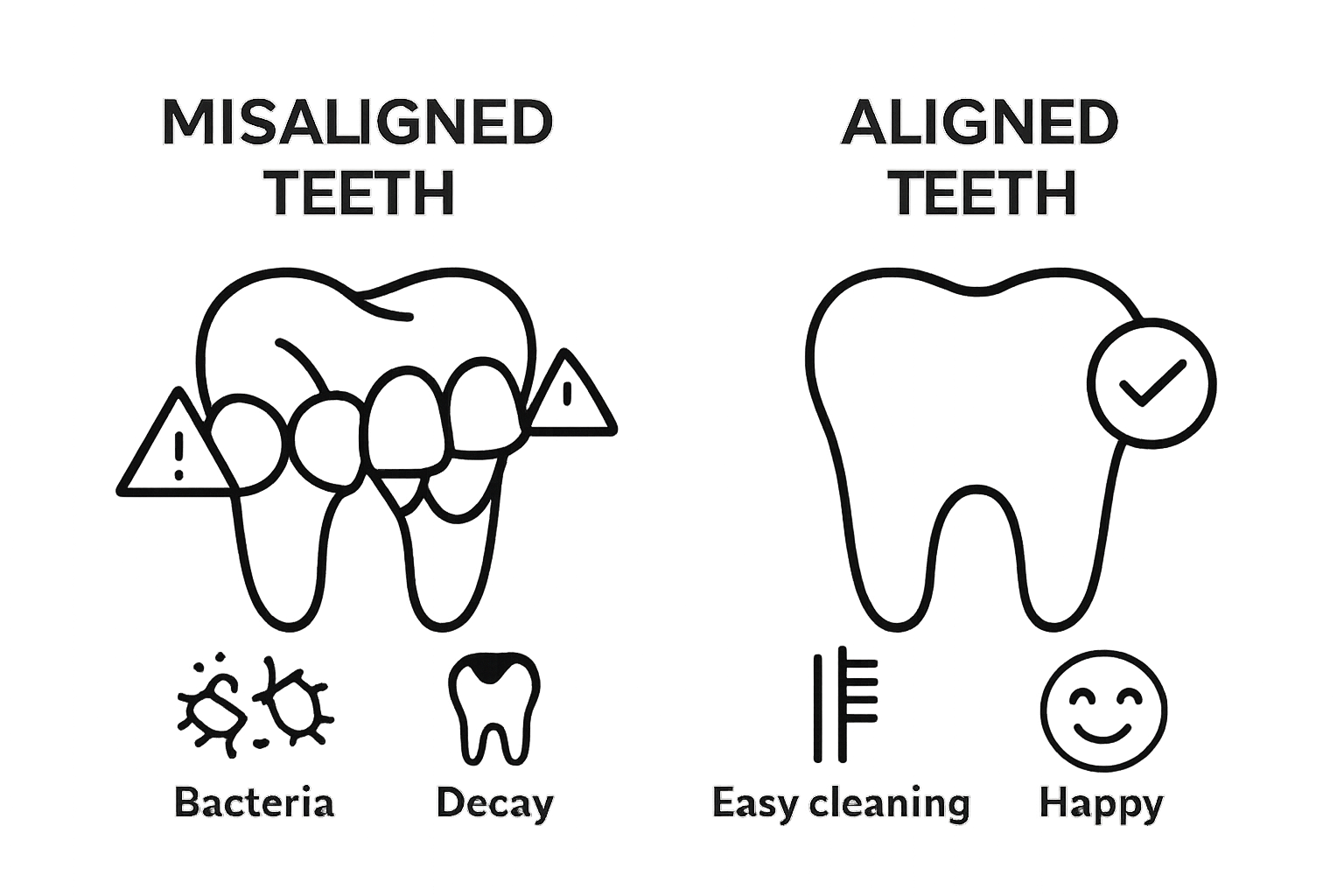Understanding Why Teeth Shift: A Family Guide
September 17, 2025
Understanding Why Teeth Shift: A Family Guide
Most people think their teeth stay in the exact same spot for life. They are surprised to learn that even healthy teeth are always on the move and can gradually shift position as you age. What actually causes this constant motion might have more to do with your daily habits and simple everyday pressures than genetics or dramatic dental events.
Table of Contents
- What Causes Teeth to Shift Over Time?
- The Importance of Proper Tooth Alignment
- Factors Influencing Tooth Movement
- The Role of Age and Development in Teeth Shifting
- How Orthodontics Can Help Correct Shifting Teeth
Quick Summary
| Takeaway | Explanation |
|---|---|
| Teeth constantly shift throughout life. | Tooth movement is a normal biological process influenced by aging, pressure, and health. |
| Proper alignment affects oral health significantly. | Aligned teeth ensure better function and prevent complications like decay and gum disease. |
| External pressures influence tooth positioning. | Habits such as grinding, uneven bites, and muscle pressures can lead to gradual shifts. |
| Professional assessments are crucial. | Regular dental evaluations help identify changes in alignment and advise on necessary interventions. |
| Orthodontics offers effective realignment solutions. | Treatments like braces and aligners can correct misalignments, improving both health and aesthetics. |
What Causes Teeth to Shift Over Time?
Teeth are not permanently fixed in place as many people assume. They are dynamic structures capable of gradual movement throughout an individual’s lifetime. Understanding why teeth shift requires examining multiple biological and environmental factors that influence dental positioning.
Natural Aging and Bone Remodeling
As we age, our jaw bones undergo continuous remodeling processes that subtly impact tooth alignment. Research from the Journal of Dental Research reveals that physiological tooth movement occurs naturally due to several interconnected mechanisms:
- Bone density changes
- Muscle and soft tissue pressure
- Gradual ligament elasticity modifications
These ongoing transformations mean that teeth are never truly static, but constantly experiencing microscopic positional adjustments.
External Pressure and Biomechanical Forces
External factors play a significant role in tooth movement. Persistent pressure from daily activities like chewing, speaking, and even sleeping positions can incrementally shift dental positioning. Key contributors include:
- Uneven bite patterns
- Persistent tongue positioning
- Habitual jaw clenching or grinding
Individuals who experience chronic teeth grinding (bruxism) are particularly susceptible to accelerated dental repositioning. The repetitive stress can gradually alter tooth alignment and create uneven wear patterns.
Medical and Structural Considerations
Certain medical conditions and structural changes can dramatically influence tooth movement. Missing teeth create space that neighboring teeth naturally attempt to fill, leading to potential misalignment. Periodontal diseases, which impact gum and bone health, can also create conditions that facilitate unexpected dental shifts.
Understanding these complex interactions helps individuals recognize that tooth movement is a normal biological process, not necessarily a cause for immediate concern.
The following table summarizes key factors that contribute to teeth shifting over time, clarifying how each category affects dental alignment and movement.
| Factor Category | Description | Notable Effects on Teeth |
|---|---|---|
| Natural Aging & Bone Remodeling | Gradual changes in jaw bone density and ligament elasticity as part of the aging process | Subtle ongoing adjustments in alignment |
| External Pressure & Forces | Daily habits like chewing, sleeping positions, tongue posture, grinding, or clenching | Accelerated or uneven shifting |
| Medical & Structural Changes | Loss of teeth, gum disease, and bone loss affecting space and support structures | Misalignment, increased movement |
| Biological & Physiological Triggers | Hormonal changes, genetic predispositions, periodontal ligament responses | Variable susceptibility to movement |
| Health & Lifestyle Considerations | Systemic health issues, nutritional status, and aging impact on bone and soft tissue health | Influences rate and degree of shifting |
The Importance of Proper Tooth Alignment
Tooth alignment is far more than a cosmetic concern. It represents a critical aspect of overall oral health that impacts multiple functional and physiological systems within the human body. Proper dental positioning influences everything from basic eating and speaking capabilities to long-term skeletal and muscular health.
Functional Benefits of Aligned Teeth
Research from the National Institute of Dental and Craniofacial Research highlights that correctly aligned teeth provide several essential functional advantages:
- Even distribution of bite forces
- Reduced risk of tooth damage
- Improved chewing efficiency
- Enhanced speech clarity
When teeth are properly positioned, they work together seamlessly, minimizing unnecessary stress on individual teeth and surrounding oral structures.
 This balanced approach prevents premature wear and potential structural complications.
This balanced approach prevents premature wear and potential structural complications.
Health and Preventative Considerations
Misaligned teeth create more than aesthetic challenges. They can generate significant health risks by making thorough oral hygiene substantially more difficult. Crooked or overcrowded teeth develop hard-to-clean areas where bacteria accumulate, increasing risks of:
- Tooth decay
- Gum disease
- Periodontal complications
- Potential systemic inflammatory responses
Long-Term Skeletal and Muscular Implications
Beyond immediate oral health, tooth alignment plays a profound role in broader physiological systems. Improper dental positioning can create cascading effects on jaw muscle tension, potentially leading to temporomandibular joint disorders, chronic headaches, and uneven facial muscle development.
Professional orthodontic assessment becomes crucial in identifying and addressing alignment issues before they transform into more complex medical challenges. Early intervention can prevent significant long-term health complications and ensure optimal oral function throughout an individual’s lifetime.
Factors Influencing Tooth Movement
Tooth movement is a complex biological process influenced by multiple interconnected factors. Understanding these dynamics helps explain why teeth can shift gradually or rapidly under different circumstances, revealing the intricate mechanisms governing dental positioning.
Biological and Physiological Triggers
Research from the National Institutes of Health demonstrates that tooth movement results from sophisticated biological interactions. Key physiological factors include:
- Bone density and remodeling processes
- Hormonal changes
- Genetic predispositions
- Periodontal ligament elasticity
The human body constantly remodels bone tissue, creating an environment where teeth can subtly migrate in response to internal and external pressures. These microscopic movements accumulate over time, potentially altering dental alignment.
Mechanical and External Forces
External mechanical forces play a significant role in tooth positioning. Consistent pressure from various sources can incrementally shift dental structures. Important mechanical influences encompass:
- Bite patterns and occlusal forces
- Tongue positioning
- Chronic teeth grinding
- Muscular pressures from facial movements
Persistent mechanical stress can create gradual but meaningful changes in tooth alignment. For instance, habitual tongue positioning or uneven chewing patterns might cause teeth to drift incrementally over months or years.
Health and Lifestyle Considerations
Individual health conditions and lifestyle factors substantially impact tooth movement. Systemic health issues, nutritional deficiencies, and age-related changes can accelerate or modify dental positioning. Specific considerations include tooth loss, which creates space for adjacent teeth to migrate, and medical conditions that affect bone metabolism.
Professional dental monitoring becomes crucial in understanding and managing these complex interactions. Regular assessments help identify potential alignment shifts early, allowing for proactive intervention and maintaining optimal oral health.
The Role of Age and Development in Teeth Shifting
Dental development is a dynamic process that extends far beyond childhood, influencing tooth positioning throughout an individual’s lifetime. Understanding how age impacts dental structures provides critical insights into the complex mechanisms of tooth movement and potential alignment changes.
Childhood and Developmental Stages
Research examining dental development reveals that teeth undergo significant transformations during different life stages. Key developmental characteristics include:
- Gradual eruption of permanent teeth
- Jaw bone growth and expansion
- Changes in dental arch width
- Modification of bite relationships
Children experience rapid dental changes as primary teeth are replaced by permanent dentition. These transitions create natural spaces and shifts that contribute to overall dental alignment and positioning.
Adolescent and Young Adult Transitions
Adolescence represents a critical period of dental development characterized by substantial structural modifications. Hormonal changes and continued skeletal growth significantly influence tooth positioning. Factors such as wisdom tooth emergence can create additional pressures that cause unexpected dental shifts.
Muscle development, jaw growth, and ongoing bone remodeling contribute to incremental changes in dental alignment. Some individuals may experience more pronounced movement during these developmental stages, potentially requiring orthodontic intervention.
Age-Related Dental Transformations
As individuals progress through adulthood, teeth continue to experience subtle but meaningful positional changes. Bone density reduction, muscle tone modifications, and cumulative mechanical stresses contribute to ongoing dental repositioning.
Professional dental monitoring becomes increasingly important with age. Regular assessments help track developmental changes, identify potential alignment issues, and recommend appropriate interventions to maintain optimal oral health and functional dental positioning.

How Orthodontics Can Help Correct Shifting Teeth
Orthodontic interventions represent sophisticated medical approaches designed to address complex dental misalignment issues. These treatments go beyond cosmetic improvements, providing comprehensive solutions for structural dental challenges that impact overall oral health and functionality.
Understanding Orthodontic Correction Mechanisms
Research from Johns Hopkins Medicine highlights that orthodontic treatments work by applying controlled, strategic pressure to gradually reposition teeth. Key correction mechanisms include:
- Systematic application of biomechanical forces
- Controlled bone remodeling
- Gradual teeth repositioning
- Comprehensive arch development
These mechanisms allow orthodontists to create precise, predictable tooth movements that address underlying structural irregularities. The process involves carefully calculated forces that stimulate bone resorption and deposition, enabling teeth to shift into optimal positions.
Treatment Options and Technological Advances
Modern orthodontics offers multiple approaches for correcting shifting teeth, ranging from traditional braces to innovative clear aligner technologies. Each method provides unique advantages tailored to individual dental requirements:
- Metal braces for complex realignments
- Ceramic braces for aesthetic considerations
- Clear aligners for subtle, removable corrections
- Lingual braces for completely hidden treatments
Advanced computational modeling and 3D imaging now enable orthodontists to design extremely precise treatment plans, predicting tooth movement with unprecedented accuracy.
Long-Term Benefits and Considerations
Orthodontic interventions extend far beyond immediate aesthetic improvements. Properly aligned teeth contribute to enhanced oral function, reduced risk of dental complications, and improved overall health. By addressing misalignments early, patients can prevent potential future issues such as uneven wear, jaw disorders, and difficulties with oral hygiene.
Professional consultation remains crucial in determining the most appropriate orthodontic strategy.
This table compares popular orthodontic treatment options discussed in the article, helping readers understand each method’s features and primary benefits.
| Orthodontic Option | Description | Main Benefits |
|---|---|---|
| Metal Braces | Traditional metal brackets and wires | Highly effective for complex cases |
| Ceramic Braces | Tooth-colored or clear brackets | More discreet than metal braces |
| Clear Aligners | Removable transparent trays (e.g., Invisalign) | Nearly invisible, removable design |
| Lingual Braces | Braces attached to the back side of teeth | Hidden from view, aesthetic appeal |
| Advanced 3D Planning | Use of digital imaging for precise treatment planning | Enhanced accuracy and customization |
Get Ahead of Shifting Teeth: Protect Your Family’s Smiles
Have you noticed small gaps or changes in your family’s smiles? The natural shifting of teeth described in our guide can lead to much bigger dental challenges down the road. Everyday habits, natural aging, and missed dental checkups all contribute to gradual tooth movement—sometimes causing pain, affecting appearance, or making oral care harder. If you’re worried about bone remodeling, uneven bite patterns, or early signs of misalignment, you are not alone. Many families share these concerns but there are personalized solutions to help you today.

Take control of your oral health before minor shifts turn into major problems. The team at Glow Orthodontics specializes in orthodontic treatments for children, teens, and adults. Experience a warm and professional environment where your family’s comfort comes first. Explore your options for braces and Invisalign, see real patient testimonials, or easily book your consultation. Your path to a healthier, more confident smile starts with a visit—secure your spot today and enjoy peace of mind knowing your teeth are in expert hands.
Frequently Asked Questions
What causes teeth to shift over time?
Teeth can shift due to natural aging processes, changes in bone density, external pressure from activities like chewing and speaking, and specific medical conditions that create space or misalignment.
How can orthodontics help with shifting teeth?
Orthodontics uses controlled pressure to gradually reposition teeth, correcting misalignment through various methods such as braces and clear aligners, which promote proper dental function and reduce complications.
What are the health risks associated with misaligned teeth?
Misaligned teeth can make oral hygiene difficult, leading to increased risks of tooth decay, gum disease, and potential systemic health issues due to inflammation or infection.
How does age affect tooth movement?
As individuals age, factors like bone density reduction, hormonal changes, and cumulative mechanical stress contribute to subtle shifts in tooth positioning, making regular dental monitoring essential for maintaining oral health.